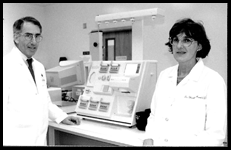INTEREST GROUP GAZETTE
Therapeutic Oligonucleotides Interest Group
The second NIH symposium on Therapeutic Oligonucleotides will be held Friday, December 5, 1997, from 8:30 a.m. to 5:30 p.m. in Masur Auditorium (at the Clinical Center.) and will address "Targeting Transcription Factors and Signaling Pathways." For further information, contact:
Yoon Sang Cho-Chung
Head, Therapeutic Oligonucleotides Interest Group, NCI
Tel: (301) 496-4020
FAX: (301) 496-2443
Email: <yc12b@nih.gov>
Cornea Interest Group
They can't go on meeting like this, so after a year of meetings without benefit of official status, the Cornea Interest Group has formally organized as such. The group exchanges ideas on a variety of topics related to the ocular cornea, reviews papers in the field, and discusses current experimental findings, problems, and technical developments. Members are clinical and basic researchers from NIH and from local universities.
Meeting Time: first Monday of each month, 9:00-10:00 am
Meeting Place: Building 6, Room 412
Contact: Christina Sax
Phone: 402-4342
E-mail: <sax@helix.nih.gov>
Birth Defects and Teratology Interest Group
Contrary to information in the otherwise flawless Interinstitute Interest Group Directory pullout in the July-August Catalyst, the telephone number for contact person Dorothea de Zafra, of NIAAA, is 443-6516.
The interest group's web site is <http://www.nih.gov/sigs/birth-def/>.
Social Structure and Demographic Issues in Health Interest Group
The new e-mail address for contact person Laura Montgomery, NCHS/CDC, is <lem3@cdc.gov>.
In Vivo NMR Interest Group
The name of this new interest group was established at a September founding meeting, at which it was also decided that the group would be open to all intramural denizens with an interest in the science, technology, and in vivo application of magnetic resonance.
The group's mission is threefold: to encourage the use of MRI/MRS in biomedical applications, to promote interdisciplinary research and communication, and to disseminate information and provide consultative expertise.
The group intends to organize a seminar series and develop yellow pages of NIH groups involved in MRI research, a listserver with e-mail addresses of members, a calendar of events, and other vehicles for connecting people with similar research interests. They already have a web site: <http://www-mrips.cc.nih.gov/MRI>.
Meeting time: Alternate Wednesdays at 1:30 pm
For more info or to present your work during a Wednesday meeting, contact Jeff Duyn at
<jhd@helix.nih.gov>.
